AI Text-to-Image Prompt Generator [Start for Free]
Create Breathtaking AI Images and AI Art by using the right prompts. Start with an AI Text-to-Image Prompt Generator for free.
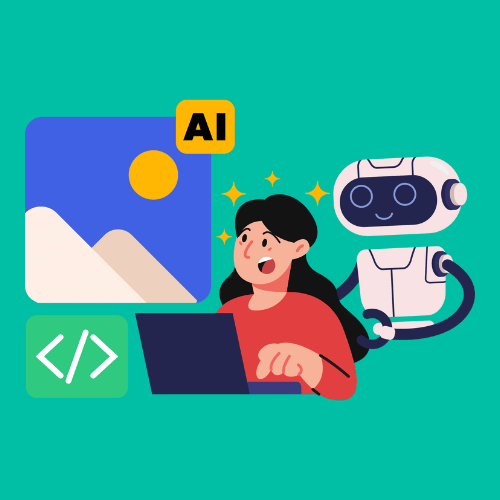
AI has come a long way when it comes to creating stunning Text-to-Image photos and AI Art.
One thing that did not change is that the quality of your input (Prompt) determines the quality of your output (Image).
In this article, we’re going to have a look at how AI can help you brainstorm Text-to-Image prompts.
Let’s get into it.
Here’s how AI Text to Image Generators Work [Video Tutorial]
In this article
- Veja como funcionam os geradores de texto para imagem de IA [tutorial em vídeo]
- O que é um gerador de texto para imagem alimentado por IA
- O que é um gerador de prompt de texto para imagem com tecnologia de IA
- Como criar prompts de texto para imagem com ChatGPT
- Personalize seus prompts de texto para imagem de IA
- Exemplos de estilo de prompt de texto para imagem AI
- Os melhores geradores de texto para imagem com inteligência artificial
- 1. StoryLab.aiGerador de texto para imagem alimentado por IA
- 2. Gerador de texto para imagem Writesonic / Photosonic AI
- 3. Gerador de texto para imagem de hipotenusa AI
- O futuro dos geradores de imagens de IA
- Melhores práticas usando geradores de imagens de IA
- Perguntas frequentes
- Mais exemplos de conversão de texto em imagem de IA
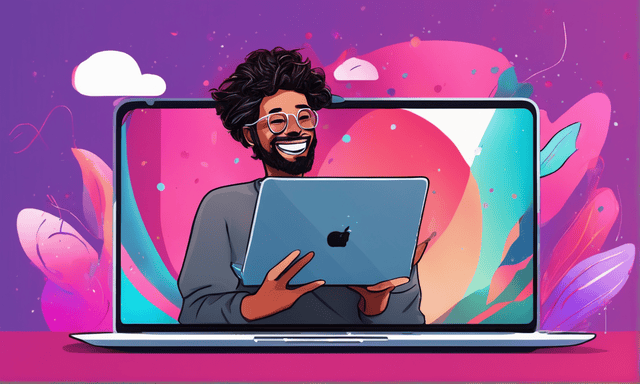
What is an AI-Powered Text-To-Image Generator
An AI text-to-image generator is a machine learning system that produces visual representations based on textual descriptions. It translates written prompts into corresponding visual imagery.
The images you see in this article are created with an AI Text-to-Image generator. It’s worth mentioning that the quality of the images AI is able to create is improving drastically month-over-month.
If you have not try it out yet, be sure to do so. Here is a list of the Best AI Text-to-Image Generators.
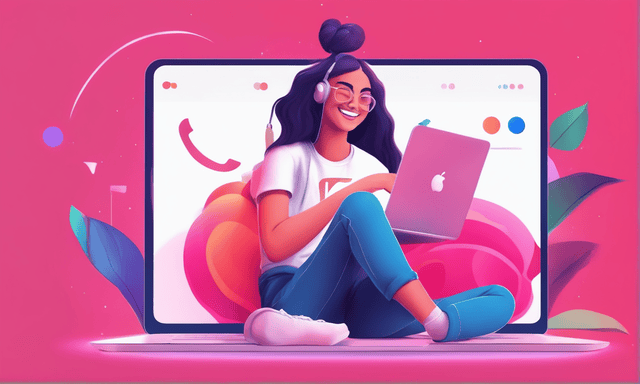
What is an AI-Powered Text-To-Image Prompt Generator
An AI text-to-image prompt generator is a system that creates textual descriptions to elicit specific visual outputs from a text-to-image model. It helps guide the generation of images based on crafted textual cues.
It can be difficult to come up with creative text-to-image prompts. Especially when you’re just starting off. In order to not get discouraged, be sure to use an AI Text-to-Image prompt generator like ChatGPT.
How to Create Text-to-Image Prompts with ChatGPT
ChatGPT is great for a variety of use cases. Coming up with Text-to-Image Prompts is one of them.
The best way to go about it is to:
- Start broad;
- Get inspired by trying out the prompts;
- Get specific.
Here’s an example of us trying to come up with AI Images for a Gardening Article:
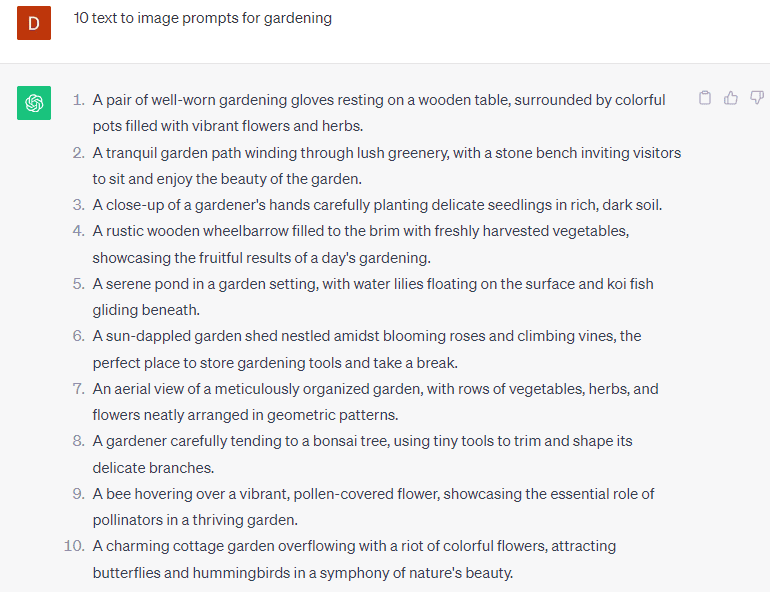
In the ChatGPT Example you see that we started very broad. We then took a couple of examples, used a Text-to-Image Generator and played around with the ones we liked best. Here are a couple of examples we’ve generated on the first, generic, try:
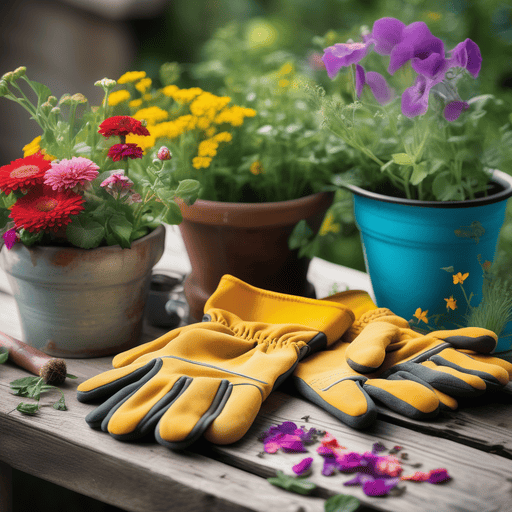
AI Prompt used:
A pair of well-worn gardening gloves resting on a wooden table, surrounded by colorful pots filled with vibrant flowers and herbs.

AI Prompt used:
A tranquil garden path winding through lush greenery, with a stone bench inviting visitors to sit and enjoy the beauty of the garden.
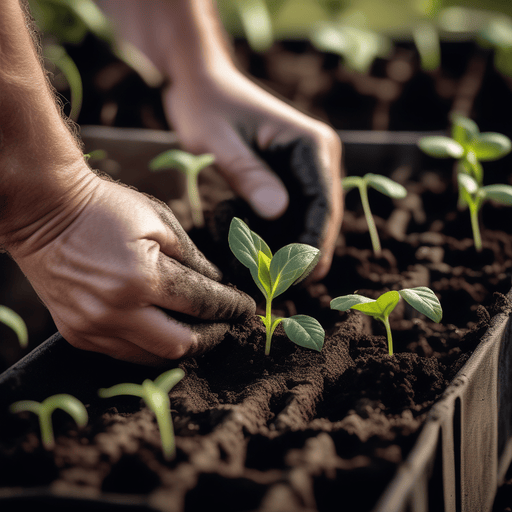
AI Prompt used:
A close-up of a gardener’s hands carefully planting delicate seedlings in rich, dark soil.
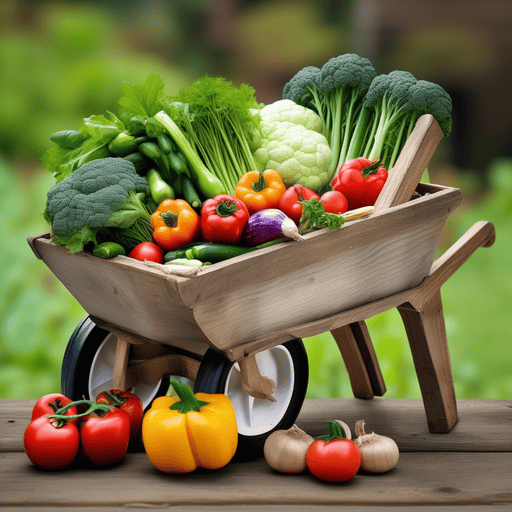
AI Prompt used:
A rustic wooden wheelbarrow filled to the brim with freshly harvested vegetables, showcasing the fruitful results of a day’s gardening.
Customize your AI Text-to-Image Prompts
During this step, you can take what you like, add or remove details, and create your more defined AI Images.
You can also add colors, styles and more.
For instance, I changed the last image prompt to only show tomatoes. On the first run, I also got green tomatoes so I changed the prompt to yellow and red tomatoes. Here’s what it looks like:
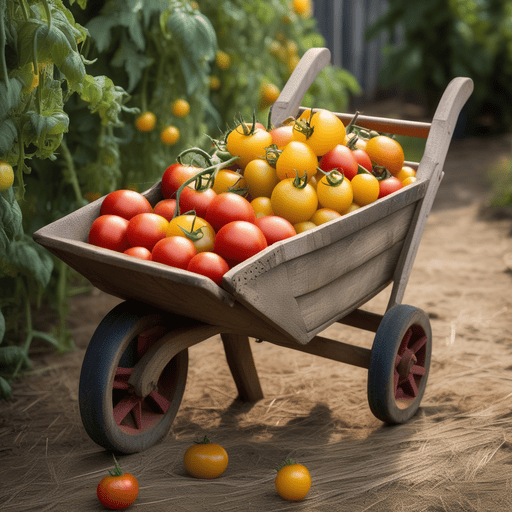
AI Prompt used:
A rustic wooden wheelbarrow filled to the brim with freshly harvested red and yellow tomatoes, showcasing the fruitful results of a day’s gardening.
You can also change the style of the image in your prompt.
AI Text-to-Image Prompt Style Examples
Here are a couple of examples of AI Text-to-Image prompt styles:
- Realistic;
- Digital art;
- Drawing;
- Style of (famous artist);
- 3D;
- Extremely realistic
- DMT art style
- 8-bit
- Pixelated
- Pointillism
- Core it!
- Infrared
- Tilt-shift photography
- Trompe l’oeil
- Anamorphic art
- Ambient occlusion
- Geometric abstraction
- Mandala
- Art nouveau
- Majolica
- Kintsugi
- Batik
- Kirigami
- Mosaic
- Bacteria art
- Punk It!
- Ferrofluid
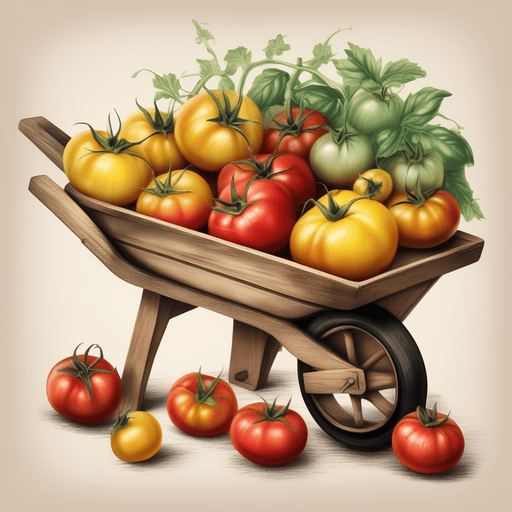
AI Prompt used:
A rustic wooden wheelbarrow filled to the brim with freshly harvested red and yellow tomatoes, showcasing the fruitful results of a day’s gardening, drawing
The Best AI-Powered Text-To-Image Generators
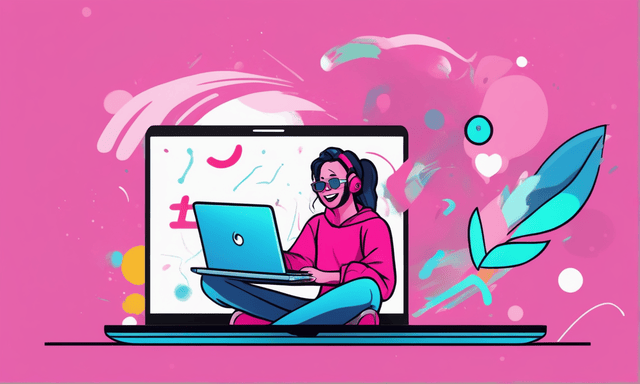
There are quite a some AI-Powered Text-To-Image Generators to choose from and they’re getting better, fast! Our goal is not to present you with a massive list of AI Tools but rather to narrow it down to a couple of great ones.
Check out our list below.
Enjoy!
1. StoryLab.ai’s AI-Powered Text-To-Image Generator
StoryLab.ai has more than 100,000 users and has been developing its tools for years. Set up a free account and simply enter what type of image you want to create and the AI Text-To-Image Creator will do the work.
Here’s how it works.
Let’s say we want to create an image for an article or social post about marketing or tech. I simply enter ‘happy person typing on a laptop, digital art’ and let AI do the work’. The better you describe what your image should be about (prompt), the better the output.
Here’s what the AI Image Maker Generated for us:
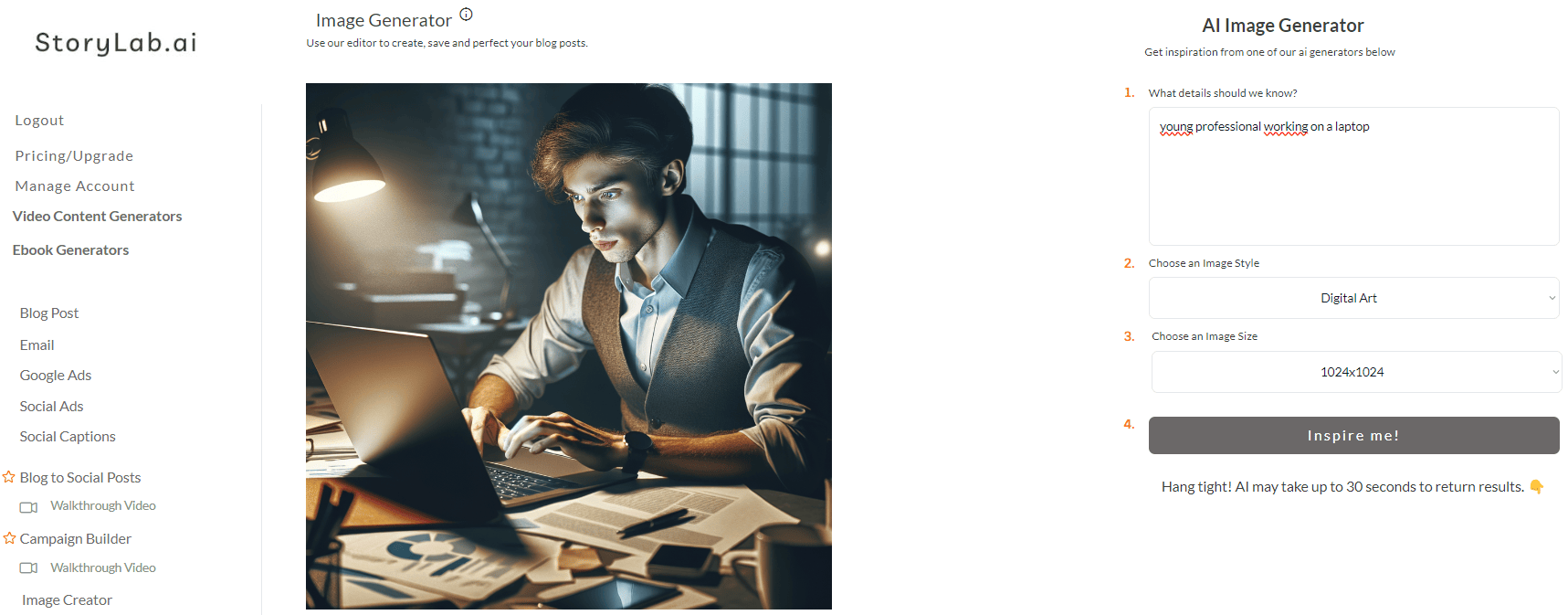
2. Writesonic / Photosonic AI Text To Image Generator
Unleash your creativity on the screen with the AI Art Generator of Writersonic / Photosonic.
Design something completely unique and unprecedented. Let Writesonic’s AI art generator serve as your artistic tool, eliminating the need to search for stock images and wait for weeks to receive new creative assets. Embrace a new era of limitless possibilities in your artistic endeavors.
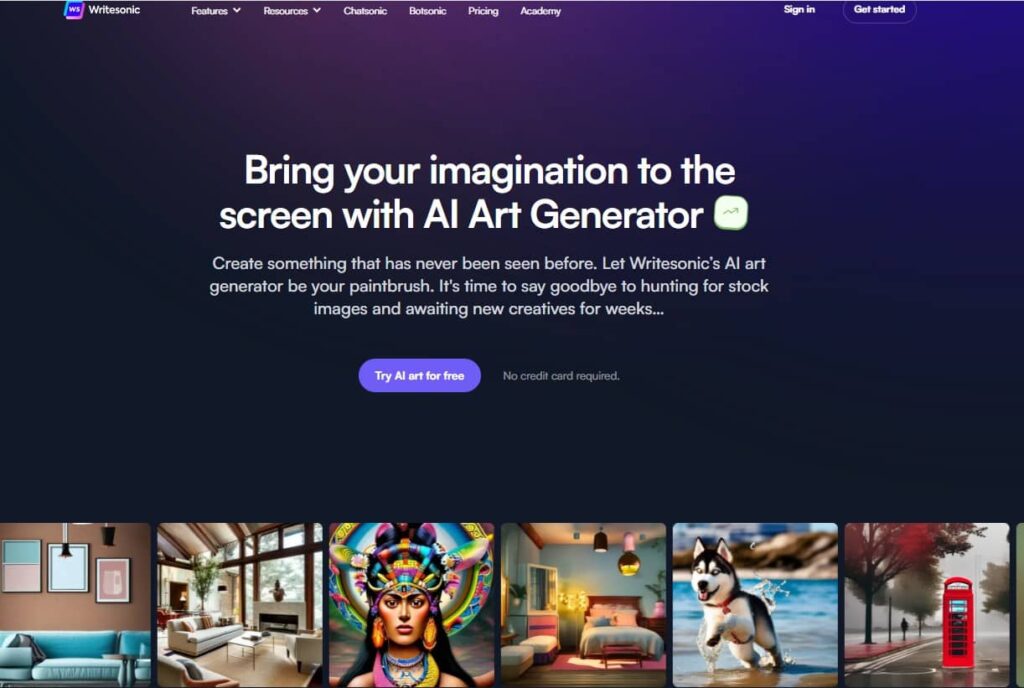
3. Hypotenuse AI Text To Image Generator
Produce breathtaking and entirely unique images in an instant with Hypotenuse AI’s Text To Image Generator.
Unleash the creativity from and effortlessly generate images and art for any situation using our state-of-the-art text-to-image AI generator.
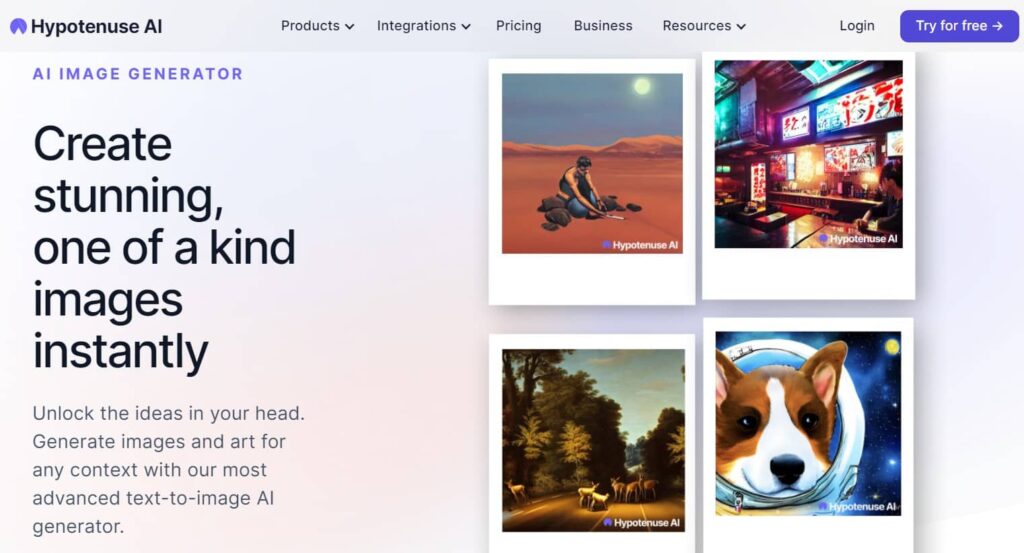
The Future of AI Image Generators
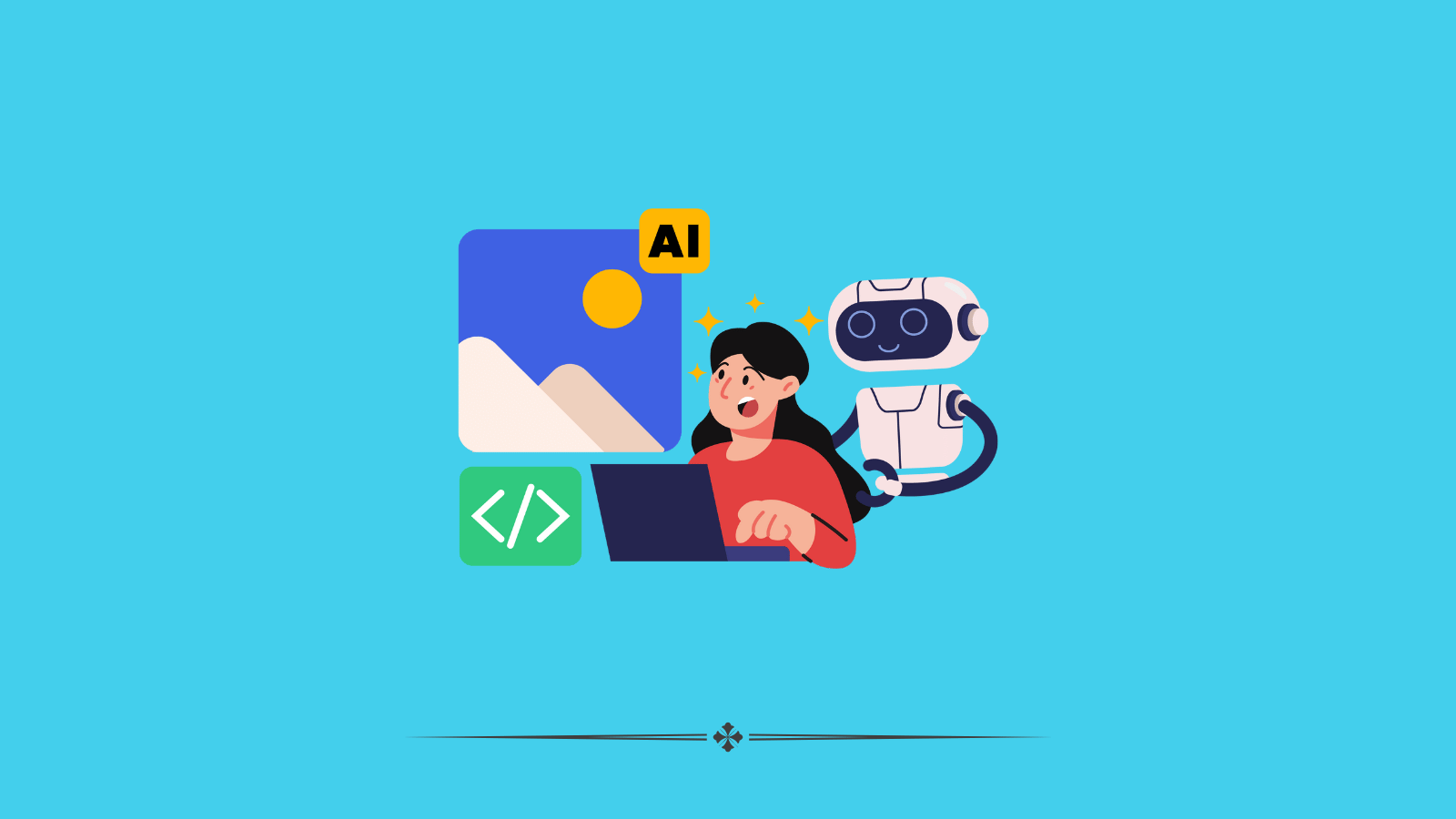
The future of AI image generators is poised to be transformative, impacting various sectors from creative industries to scientific research. Here are some key trends and potential developments you need to keep in mind if you want to use an ai image generator.
1. Improved Realism and Quality
Higher Resolution and Detail:
- Future AI models will generate images with even higher resolutions and more intricate details, making them nearly indistinguishable from real photographs.
Advanced Texture and Lighting:
- Enhanced algorithms for texture and lighting will produce more lifelike and dynamic images.
2. Creative and Artistic Applications
Art and Design:
- Artists and designers will use AI to experiment with new styles and concepts, pushing the boundaries of creativity.
Personalized Content:
- AI will create customized images tailored to individual preferences, enhancing marketing and entertainment experiences.
3. Accessibility and User-Friendly Interfaces
Simplified Tools:
- User interfaces will become more intuitive, allowing individuals with little to no technical knowledge to create high-quality images.
Voice and Text Commands:
- Natural language processing will enable users to generate images using simple voice or text descriptions.
4. Integration with Other Technologies
Augmented and Virtual Reality (AR/VR):
- AI-generated images will enhance AR/VR environments, creating more immersive and interactive experiences.
3D Modeling and Printing:
- AI will assist in generating 3D models for printing, revolutionizing industries like manufacturing, healthcare, and architecture.
5. Ethical and Legal Considerations
Content Moderation:
- Enhanced moderation tools will be necessary to prevent the creation and distribution of harmful or inappropriate content.
Intellectual Property:
- New regulations and frameworks will be developed to address the copyright and ownership issues related to AI-generated content.
6. Diverse and Inclusive Representation
Bias Mitigation:
- Efforts will focus on reducing biases in AI training data to ensure diverse and inclusive representation in generated images.
Cultural Sensitivity:
- AI systems will be designed to be culturally aware, producing content that respects and reflects various cultural contexts.
7. Applications in Education and Training
Educational Tools:
- AI-generated visuals will be used in educational materials, providing dynamic and engaging learning experiences.
Training Simulations:
- Realistic simulations for training in fields such as medicine, aviation, and military will benefit from advanced AI-generated imagery.
8. Environmental and Resource Considerations
Sustainable AI:
- Development of more energy-efficient algorithms to reduce the environmental impact of training large AI models.
Resource Allocation:
- Optimized use of computational resources to make AI image generation more accessible and affordable.
9. Enhanced Interactivity and Personalization
Interactive Art:
- AI will enable the creation of interactive artworks that respond to viewers’ actions or emotions.
Personal Avatars and Digital Twins:
- AI will generate personalized avatars and digital twins for use in virtual environments, social media, and gaming.
10. Collaboration and Co-Creation
Human-AI Collaboration:
- Artists and creators will increasingly collaborate with AI, blending human creativity with machine precision and innovation.
Crowdsourced Input:
- AI platforms will incorporate feedback and input from diverse user communities to improve and evolve.
The future of AI image generators is bright, with vast potential to revolutionize numerous fields. As technology advances, it will be crucial to address ethical and legal challenges while maximizing the positive impact on society.
Best Practices Using AI Image Generators

Using AI image generators effectively requires understanding both their capabilities and limitations. Here are some best practices to help you make the most out of these powerful tools:
1. Define Clear Objectives
- Purpose Identification: Clearly understand why you need the AI-generated images—be it for marketing, artistic projects, or product designs.
- Target Audience: Tailor the generated images to resonate with your intended audience.
2. Choose the Right Tool
- Tool Selection: Different AI image generators have varying strengths. Choose a tool that aligns with your specific needs (e.g., DALL-E for creative art, MidJourney for artistic styles).
- Experimentation: Experiment with multiple tools to understand their unique capabilities and outputs.
3. Provide Detailed Prompts
- Specific Descriptions: The more detailed and specific your prompt, the more likely you are to get the desired output.
- Context and Style: Include contextual information and style preferences in your prompts to guide the AI.
4. Iterate and Refine
- Multiple Attempts: Don’t settle for the first result. Generate multiple versions and refine your prompts based on the outcomes.
- Feedback Loop: Use the feedback to tweak and improve subsequent prompts for better results.
5. Ensure High-Quality Outputs
- Resolution and Format: Ensure the generated images are of high resolution and in the correct format for your use case.
- Post-Processing: Be prepared to use photo editing software for any necessary touch-ups or enhancements.
6. Legal and Ethical Considerations
- Usage Rights: Understand the licensing and usage rights associated with the AI-generated images.
- Ethical Use: Avoid creating misleading or harmful content. Be mindful of ethical implications and cultural sensitivities.
7. Integration with Other Tools
- Workflow Integration: Integrate AI image generators into your existing workflow for seamless creation and editing.
- Complementary Tools: Use complementary tools like Adobe Photoshop or Illustrator for further refinement.
8. Stay Updated with Developments
- New Features: AI tools evolve rapidly. Stay updated with new features and improvements to leverage the latest capabilities.
- Community and Support: Engage with user communities and support forums to learn tips, tricks, and best practices from other users.
9. Data Privacy
- Sensitive Information: Avoid using prompts that include sensitive or personal information to protect privacy.
- Secure Platforms: Use reputable platforms that adhere to strong data privacy standards.
10. Creative Exploration
- Artistic Freedom: Don’t be afraid to experiment and push the boundaries of what the AI can generate.
- Inspiration: Use AI-generated images as a source of inspiration for further creative projects.
11. Efficiency and Productivity
- Batch Processing: Use batch processing features if available to generate multiple images in one go.
- Automated Workflows: Set up automated workflows for repetitive tasks to save time and effort.
12. Documentation and Archiving
- Record Keeping: Keep a record of your prompts and settings for future reference and reproducibility.
- Organized Storage: Store generated images in an organized manner for easy access and retrieval.
Conclusion
By following these best practices, you can harness the power of AI image generators to create high-quality, impactful images efficiently and ethically. Whether for professional use or personal projects, these guidelines will help you maximize the potential of AI-generated imagery.
FAQ
Q: What is an AI text-to-image prompt generator?
- An AI text-to-image prompt generator is a tool that uses artificial intelligence to generate creative prompts, which can then be used to produce images via text-to-image AI software.
Q: How does an AI prompt generator work for text-to-image creation?
- These generators use natural language processing (NLP) to create descriptive, imaginative, and often complex prompts that are fed into text-to-image AI models, like DALL-E or GPT-4, to generate corresponding images.
Q: What are the benefits of using AI for generating text-to-image prompts?
- Benefits include inspiring creativity, providing a starting point for complex image generation, saving time in prompt formulation, and exploring a wide range of artistic ideas.
Q: Can AI prompt generators create prompts for specific themes or styles?
- Yes, AI generators can tailor prompts for specific themes, artistic styles, or subjects based on user inputs, allowing for customized image generation.
Q: How detailed can AI-generated prompts be for text-to-image software?
- AI-generated prompts can range from basic to highly detailed, describing specific scenarios, objects, styles, and settings to guide the image creation process.
Q: Are AI-generated prompts effective in generating high-quality images?
- The effectiveness depends on the complexity of the prompt and the capabilities of the text-to-image AI software. Detailed and well-structured prompts generally yield better-quality images.
Q: How do AI prompt generators incorporate artistic elements into prompts?
- Many AI generators are trained on artistic concepts and can incorporate elements like color schemes, artistic movements, and composition styles into prompts.
Q: What are the limitations of using AI for text-to-image prompt generation?
- Limitations include potential lack of nuance or specificity, challenges in accurately capturing abstract concepts, and the need for manual refinement to achieve desired outcomes.
Q: How can artists and designers use AI prompt generators for inspiration?
- Artists and designers can use AI prompt generators to spark new ideas, overcome creative blocks, or explore different visual styles and concepts for their projects.
Q: Are AI prompt generators suitable for generating prompts for all types of images?
- While suitable for a wide range of image types, AI prompt generators may be less effective for extremely abstract, highly technical, or culturally specific imagery without additional input or guidance.
Q: How can AI prompt generators be customized for specific industries or themes?
- AI prompt generators can be customized by inputting industry-specific terms, themes, and styles, allowing users to generate prompts that are more relevant to their specific field, like fashion, architecture, or advertising.
Q: Can these tools generate prompts for educational or scientific illustrations?
- Yes, AI prompt generators can be used to create prompts for educational or scientific illustrations by incorporating technical terms and concepts relevant to the subject matter.
Q: Are AI-generated prompts for text-to-image creation suitable for marketing and advertising?
- AI-generated prompts can be suitable for marketing and advertising, providing creative starting points for visual content that can be further refined to align with branding and campaign goals.
Q: How do AI prompt generators handle complex or abstract concepts?
- While AI generators can handle a range of concepts, they might struggle with highly abstract or complex ideas. In such cases, breaking down the concept into simpler components in the prompt can be helpful.
Q: Can AI prompt generators suggest different artistic styles or genres?
- Many AI prompt generators are capable of suggesting a variety of artistic styles or genres, such as surrealism, impressionism, or futuristic, helping users explore diverse visual aesthetics.
Q: How user-friendly are AI prompt generators for non-technical users?
- Most AI prompt generators are designed to be user-friendly, with simple interfaces that allow non-technical users to input data and generate creative prompts easily.
Q: Can AI-generated prompts be used for generating animations or only static images?
- Currently, most AI text-to-image software focuses on generating static images, but advancements are being made towards using AI for animation, where prompts could guide the creation of animated sequences.
Q: What ethical considerations should be taken into account when using AI for prompt generation?
- Ethical considerations include ensuring the generated content is culturally sensitive, does not perpetuate biases or stereotypes, and respects intellectual property and artistic originality.
Q: How can AI prompt generators assist in content creation for social media?
- AI prompt generators can assist in social media content creation by providing unique and engaging visual ideas that can be transformed into eye-catching posts for platforms like Instagram, Pinterest, or Facebook.
Q: What future developments are expected in AI prompt generation for text-to-image creation?
- Future developments may include more advanced customization options, improved understanding of complex and abstract concepts, and integration with various forms of media for more dynamic and interactive content creation.
Q: How can AI prompt generators adapt to different cultural contexts in image creation?
- Advanced AI prompt generators can incorporate cultural contexts by analyzing and learning from diverse datasets, though manual input may be needed for specific cultural nuances.
Q: Are AI-generated prompts for text-to-image creation customizable for branding purposes?
- Yes, these prompts can be customized to align with branding requirements by incorporating specific brand elements, colors, and themes into the input.
Q: Can AI prompt generators assist in creating content for digital art portfolios?
- AI generators can be valuable tools for digital artists, providing creative prompts that can inspire unique artwork for their portfolios.
Q: How do AI prompt generators ensure the uniqueness of each generated prompt?
- AI generators ensure uniqueness by combining various elements and concepts in novel ways, though similar inputs may produce prompts with overlapping themes.
Q: Can these tools be used for generating prompts for product design and conceptualization?
- AI prompt generators can be useful in product design by providing creative and innovative prompts that can spark new ideas for product development and conceptualization.
Q: How can educators utilize AI prompt generators in teaching art and design?
- Educators can use these tools to generate prompts for student projects or assignments, encouraging exploration and creativity in art and design education.
Q: What is the role of user feedback in refining AI prompt generation?
- User feedback helps in refining AI algorithms, ensuring that the prompts are more aligned with user expectations and creative goals over time.
Q: How do AI prompt generators handle requests for specific color schemes or visual elements?
- AI generators can incorporate specific color schemes or visual elements into prompts if such details are included in the input, guiding the subsequent image generation process.
Q: Are there ethical considerations in using AI for generating art prompts, considering originality?
- Ethical considerations include ensuring that the AI-generated prompts do not infringe on existing artworks’ intellectual property and maintaining a balance between inspiration and originality.
Q: How can AI-generated prompts be integrated into collaborative art projects or workshops?
- AI-generated prompts can be used as starting points in collaborative art projects or workshops, offering a shared basis for creativity and exploration among participants.
More AI Text-To-Image Examples
- Ariana Grande AI Art Text-To-Image Examples
- Rihanna AI Art Text-To-Image Examples
- Kim Kardashian AI Art Text-To-Image Examples
- Miley Cyrus AI Art Text-To-Image Examples
- Nicki Minaj AI Art Text-To-Image Examples
- Beyonce AI Art Text-To-Image Examples
- Selena Gomez AI Art Text-To-Image Examples
- Landscapes AI Art Text-To-Image Examples
- Owls AI Art Text-To-Image Examples
Create more and better content
Check out the following resources and Grow!